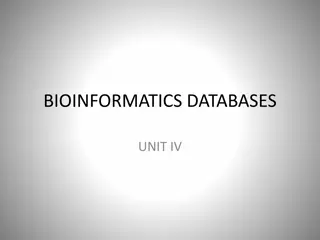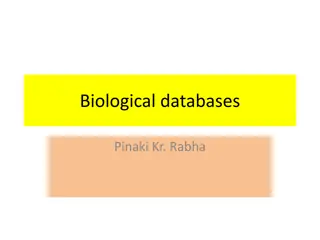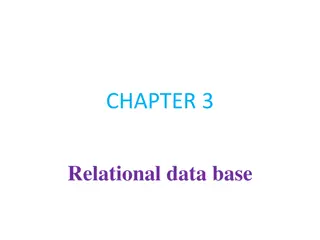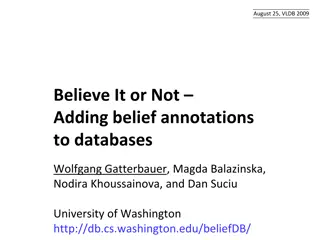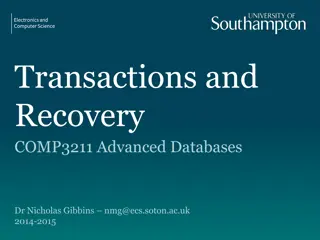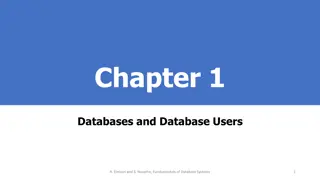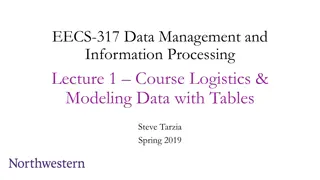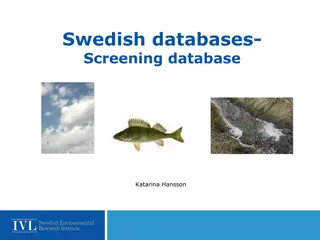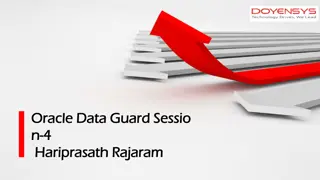Advanced Transactions in Databases: Savepoints, Chained Transactions, Long Durations
Dive into the world of advanced database transactions with topics such as savepoints, chained transactions, and long-duration challenges. Discover the importance of savepoints in handling deadlock situations and learn how chained transactions work. Explore the intricacies of long-duration transactions and the unique challenges they present.
Download Presentation

Please find below an Image/Link to download the presentation.
The content on the website is provided AS IS for your information and personal use only. It may not be sold, licensed, or shared on other websites without obtaining consent from the author.If you encounter any issues during the download, it is possible that the publisher has removed the file from their server.
You are allowed to download the files provided on this website for personal or commercial use, subject to the condition that they are used lawfully. All files are the property of their respective owners.
The content on the website is provided AS IS for your information and personal use only. It may not be sold, licensed, or shared on other websites without obtaining consent from the author.
E N D
Presentation Transcript
Advanced Transactions COMP3211 Advanced Databases Dr Nicholas Gibbins nmg@ecs.soton.ac.uk 2018-2019
Overview Savepoints Chained transactions Nested transactions Sagas 3 3
Flat Transactions Transactions considered so far are flat transactions Basic building block Only one level of control by the application All-or-nothing (commit or abort) The simplest type of transaction! 4
Long Duration Transactions Transactions considered so far are short duration Banking or ticket reservations as example applications Transactions complete in minutes, if not seconds Long-lived transactions present particular challenges More susceptible to failure (and rollback not acceptable) May lock and access many data items (increases chance of deadlock) 5 5
Savepoints Savepoint: an identifiable point in a flat transaction representing a partially consistent state which can be used as an internal restart point for the transaction Used for deadlock handling partially rollback transaction in order to release required locks Savepoints may be persistent Following a system crash, restart active transactions from their most recent savepoints 7
Savepoints START T1 operation 1 operation 2 operation 3 work covered by savepoint 1 SAVEPOINT 1 operation 4 operation 5 operation 6 operation 4 operation 5 operation 6 SAVEPOINT 3 SAVEPOINT 2 operation 7 operation 8 operation 9 operation 7 operation 8 operation 9 SAVEPOINT 4 ROLLBACK to 1 8 8
Chained Transactions Transaction broken into subtransactions which are executed serially On chaining to the next subtransaction: commit results keep (some) locks Cannot rollback to previous subtransaction START T1 operation 1 operation 2 operation 3 CHAIN operation 4 operation 5 operation 6 CHAIN 10 10
Savepoints versus Chained Transactions Both allow substructure to be imposed on a long-running application program Database context is preserved Cursors are kept Commit vs Savepoint Chained - rollback only to previous savepoint Savepoints - can rollback to arbitrary savepoint Locks Chained frees unwanted locks 11 11
Savepoints versus Chained Transactions Work lost Savepoints more flexible than flat transactions, as long as the system does not crash Restart Chained transactions can restart from most recent commit, as long as no processing context hidden in local programming variables Both organise work into a sequence of actions 12 12
Nested Transactions Transaction forms a hierarchy of subtransactions (partial order on set of subtransactions) Subtransactions may abort without aborting their parent transaction May restart subtransaction Three rules for nested transactions: Commit Rule Rollback Rule Visibility Rule 14
Nested Transactions START T START T/1 START T/1/1 invoke T/1/1 COMMIT invoke T/1 invoke T/1/2 START T/1/2 COMMIT START T/2 COMMIT invoke T/2 COMMIT START T/3 invoke T/3 START T/3/1 invoke T/3/1 COMMIT COMMIT COMMIT 15
Commit Rule The commit of a subtransaction makes the results accessible only to the parent The final commit happens only when all ancestors finally commit 16 16
Rollback Rule If any [sub]transaction rolls back, all of its subtransactions roll back 17 17
Visibility Rule Changes made by a subtransaction are visible to its parent Objects held by a parent can be made accessible to subtransactions Changes made by a subtransaction are not visible to its siblings 18 18
Observations Subtransactions are not fully equivalent to flat transactions: Atomic Consistency preserving Isolated Not durable, because of the commit rule 19 19
Observations Nesting and program modularisation complement each other Well designed module has a clean interface, and no global variables If it touches the database, the database is a large global variable If the module is protected as a subtransaction, then database changes are kept clean too Nested transactions permit intra-transaction parallelism 20 20
Emulating Nesting with Savepoints START T/1 START T START T/1/1 save T/1 save T/1/1 invoke T/1 invoke T/1/1 COMMIT save T/1/2 invoke T/1/2 COMMIT START T/1/2 START T/2 COMMIT save T/2 invoke T/2 COMMIT START T/3 save T/3 save T/3/1 invoke T/3 START T/3/1 invoke T/3/1 COMMIT COMMIT COMMIT 21
Observations Using savepoints is more flexible than nested transactions for internal recovery Can roll back further True nested transactions are needed in order to run subtransactions in parallel (Intra- transaction parallelism) Emulating with savepoints needs 'subtransactions' to be run in strict sequence True nested can pass locks selectively More flexible than savepoints Similar but different 22 22
Sagas Saga: a collection of actions (= flat transactions) that form a long-duration transaction Execution based around notion of compensating transactions Inverse of actions that allow them to be selectively rolled back Used to recover from partial execution 24
Sagas Sagas specified as a digraph Nodes are either actions or the terminal nodes abort and complete One node is designated the start Paths in graph represent sequences of actions Paths leading to abort are sequences of actions that cause the overall transaction to be rolled back Paths leading to complete are successful sequences that make persistent changes to the database 25 25
Saga Execution Each action A has a compensating transaction A-1 Assume that if A is an action and a sequence of legal actions, then A A-1 If execution of a saga leads to abort, roll back the saga by executing the compensating transactions 26 26







